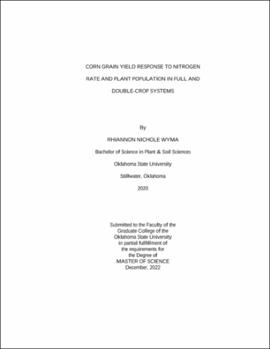| dc.contributor.advisor | Lofton, Josh | |
| dc.contributor.author | Wyma, Rhiannon Nichole | |
| dc.date.accessioned | 2023-08-02T19:47:22Z | |
| dc.date.available | 2023-08-02T19:47:22Z | |
| dc.date.issued | 2022-12 | |
| dc.identifier.uri | https://hdl.handle.net/11244/338816 | |
| dc.description.abstract | Interest in incorporating non-traditional crops like corn (Zea mays) into double-crop rotations in Oklahoma has increased recently. Work in other crops suggests differences in management between full season and double-crop, though there is limited information available on corn as a constituent of the double-crop system. As two of the most expensive inputs for corn production, optimizing nitrogen (N) application and plant populations is critical for high-risk double-crop systems. One trial was conducted over two years at three locations to determine grain yield response to these factors and assess best management practices for a double-crop wheat-corn rotation. | |
| dc.description.abstract | The study was designed to evaluate the differences between grain yield and physiological yield characteristics as they were affected by nitrogen rate and plant population treatments. Tests were conducted in 2020 and 2021 in Oklahoma. The yield characteristics evaluated were grain N (%), average kernel row⁻¹, average row cob⁻¹, kernel number, kernel weight, and cob weight. The results indicate lower yield performance at plant populations exceeding 57,000 plants ha⁻¹, though not by significant margins. This phenomenon may be explained by competition-induced stress at high plant populations. Varying responses to N rate was recorded at each location, though the best performance was recorded between 82.5 and 110 kg ha⁻¹. Though statistical analysis between full season and double-crop trials was not performed, preliminary results indicate lower N requirement for the double-crop. This may be explained by reduced biomass and dry matter accumulation fostered by the short double-crop season. Average kernel row⁻¹ was significantly impacted by plant population consistently, while N rate had limited effect. | |
| dc.description.abstract | It was concluded that grain yield was impacted by the combined effects of plant population and N rate, suggesting optimal management of both aspects is critical. Excessive plant populations create high levels of resource competition resulting in yield reductions. A result of rapid maturation of corn in this system is reduced biomass where less time is spent in vegetative growth stages. These factors alter the capability of corn to utilize N resources. | |
| dc.format | application/pdf | |
| dc.language | en_US | |
| dc.rights | Copyright is held by the author who has granted the Oklahoma State University Library the non-exclusive right to share this material in its institutional repository. Contact Digital Library Services at lib-dls@okstate.edu or 405-744-9161 for the permission policy on the use, reproduction or distribution of this material. | |
| dc.title | Corn grain yield response to nitrogen rate and plant population in full and double-crop systems | |
| dc.contributor.committeeMember | Arnall, Brian | |
| dc.contributor.committeeMember | Fultz, Lisa | |
| osu.filename | Wyma_okstate_0664M_17971.pdf | |
| osu.accesstype | Open Access | |
| dc.type.genre | Thesis | |
| dc.type.material | Text | |
| thesis.degree.discipline | Plant and Soil Sciences | |
| thesis.degree.grantor | Oklahoma State University | |
